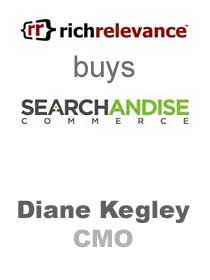 Yesterday, online shopper marketing company RichRelevance announced the acquisition of retailer search monetization provider Searchandise. According to the release, “RichRelevance currently serves more than 1.4 billion page views each month across its retail publishers and with the acquisition of Searchandise will now serve 10 of the 25 largest retailers on the web, including Target, Sears and others.” Read more.
Yesterday, online shopper marketing company RichRelevance announced the acquisition of retailer search monetization provider Searchandise. According to the release, “RichRelevance currently serves more than 1.4 billion page views each month across its retail publishers and with the acquisition of Searchandise will now serve 10 of the 25 largest retailers on the web, including Target, Sears and others.” Read more.
Yesterday, Diane Kegley, CMO of RichRelevance, discussed the transaction and its implications.
AdExchanger.com: 3M’s Raj Roa told Ad Age that buying banners on retailers sites was not effective, compared to the RichRelevance advertising platform. Does that mean that RichRelevance does not plan on offering standard banners for retailers?
DK: Since our ad server is built upon personalization software, the RichPlacement unit as well as the banners we serve tend to out-perform the market because of the relevance to the context of the consumer. Most ad servers are built to serve ads across the broader web across multiple types of content sites, whereas our ad server is built strictly for retail, and that distinction is critical when it comes to campaign performance. The ad unit of choice for a given brand varies widely. Some brands prefer integrating their brands directly within our product-recommendation technology, and some prefer banners for ease of buying at scale. For those that do prefer standard banners. There are plenty of brands that we work with that see above industry average performance with banners on our retail partner sites.
Triad Retail Media and Longboard Media are active with on-site media right now. Hooklogic and Intent Media seem to be more focused on CO-OP platforms. RichRelevance seems to focus on branded recommendations and Searchandise on cpc search results on retailers. Is there competition overlap or is the marketplace segmented enough for all parties to exist and provide complimentary services to retailers?
There’s definitely some competitive overlap in any high growth ad market, and our offerings are no exception. However, what’s clear is that personalization and relevance have to be at the core of any powerful Shopping Media offering. When ads are both personalized AND shown to consumers at the bottom of the purchase funnel, it’s an incredible combination. The competitors you mention all either are rep firms or a point solutions, but none solve for the entire equation. We respect that a lot of smart people have discovered this opportunity, and in the current market, a rising tide lifts all boats.
What hurdles does RichRelevance see in the marketplace for retailers to adopt more monetization techniques?
This market really is one of the last frontiers for large-scale ad publishing that has not yet been tapped. The advertising possibilities within this market are staggering. One needs to look no farther than Amazon as the prime example of potential. They have been in the ad market for a very long time. Since most online retailers spend 99% of their time optimizing visits into purchases instead of creating content, becoming a publisher is a very different world for them. The main hurdles that need to be overcome are 1- Ad Relevance to a consumer, 2- Convincing Endemic brands (those sold on the site) to drive traffic to product pages on the retailer’s site, instead of off the site 3- Confirmation that remnant ads won’t overtake their site (dancing mortgage lady) and 4- Overcoming fear that being a publisher will ruin their brand perception. If Amazon has proven anything here, it’s that the consumer is ok with advertising as long as it complements their shopping experience.
Where do you see retailer technology heading in the next 2-3 years- what’s the next thing?
Consumer expectations have skyrocketed to a whole new level. Those high expectations are now serving as a forcing function to get retailers to act. One of the places where we see the most change happening, and frankly driving some of the largest growth, is the multi-channel experience. Consumers EXPECT that online pricing, product, promos, and levels of service should either be the same and/or seamless offline. But they are not. They are entirely independent experiences. Most inventory back-end systems are entirely disparate, and don’t talk to each other. However, the retailers that have moved on this the most are the high-end retailers, such as Saks, Nordstrom, and Macy’s. It’s a much better experience to be able to buy apparel online and return it in a store, than to ship it back in a box and hope you get credit. Those retailers that that can marry the two worlds will see the highest growth for years to come.
Further, consumers have grown accustomed to the personalized experiences they receive online and the helpful utilities such as ratings and reviews that guide their purchase decisions — these tools allow consumers to be exposed to not just the experience of “crowd-sourcing” shopping experiences, but they are often exposed to merchandise through cross-sell and up-sell online with unique product adjacencies that they don’t see in the stores. Retailers that utilize the insights from online technology such as personalization to better inform their merchandisers’ decision-making and how products are promoted adjacent to one another (if even from a different department) will win.
By John Ebbert










